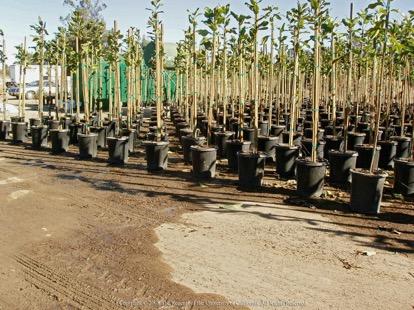Spring 2016: Evidence of pyrethroid insecticides and sediment in surface water in Lower Salinas River Watershed
Regional Report for Santa Cruz and Monterey Counties by Steve Tjosvold
There is evidence that several water drainages in the lower Salinas River Watershed have levels of pyrethroid pesticides and sediment exceeding environmental standards. As a result, the Central Coast Regional Water Quality Control Board (CCRWQCB) is proposing new Total Maximum Daily Loads (TMDLs) in the Basin Plan and therefore this new management plan, if accepted, would be implemented in the Ag Order under which agricultural producers operate in the area. These findings and the resulting new TMDLs may be a harbinger of what might occur in other similar agricultural areas in which the nursery industry operates.
In a recent meeting held in Salinas, Peter Meertens, an environmental scientist with the CCRWQCB, and Kean Goh, the Environmental Program Manager with the California Department of Pesticide Regulation, showed data from a surface water monitoring program in the lower Salinas River watershed. In the years 2011 to 2015, 111 of the 159 samples in 13 water drainages were found with sediment levels exceeding toxicity standards. Four of the 13 water drainages had pyrethroid levels exceeding toxicity standards. Three out of the five pyrethroids detected in these drainages had levels exceeding toxicity standards (bifenthrin, permethrin and lambdacyhalothrin). The pyrethroid class of insecticides adhere readily to soil particles and generally move in surface water on suspended sediment. This insecticide class is relatively inexpensive and broad spectrum and their use has increased significantly over the past 30 years since the new generation pyrethroids were introduced to markets. Five herbicides and two fungicides were detected but these detection concentrations did not exceed toxicity standards. As we have known for many years, organophosphate (OP) insecticides have been found in surface water drainages associated with agriculture. For this project, all four of the organophosphate insecticides that were detected exceeded toxicity standards. The long history of OP insecticide use and detection in the Region was the driver for the current TMDLs to mitigate organophosphate toxicity. In a somewhat startling development, the newer insecticides methoxyfenozide and chlorantraniliprole were found in more than 40% of the samples. These are insect growth regulators targeted at worm pests and fortunately did not exceed toxicity standards. However, another newer insecticide, imidacloprid, was found in over 80% of the samples and exceeded toxicity standards in over 15% of those samples. Although there are no specific regulatory actions proposed to mitigate the potential impact of imidacloprid, these findings are indicative of the risk of movement of this and other neonicotinoid insecticides in surface water. The neonicotinoid class of insecticides, as with OP insecticides, do not readily adhere to soil particles and are dissolved in any water that might flow from production areas.
Findings of these studies are available at the CCRWQCB website http://www.waterboards.ca.gov/centralcoast/water_issues/programs/tmdl/docs/salinas/sed_tox/index.shtml (see link to “TMDLs,” then link to “Salinas watershed sediment toxicity TMDL”). There will be a public hearing to consider adoption of the proposed TMDLs on May 12–13, 2016 in the Watsonville City Council Chambers. See the above link for more information.
Numerous insecticides and fungicides with active ingredients found in the lower Salinas River area drainage are used by nursery operators. Fortunately many nursery operators, where applicable, use runoff catchments to reduce or eliminate irrigation runoff from reaching surface waters. Vegetated drainage ditches and polyacrylamide may also be used to catch and hold suspended sediment before effluent flows off site. Irrigation management to minimize runoff from production areas and the use of integrated pest management to reduce the load of all pesticides generated by the nursery are essential (fig. 1). For more information see Greenhouse and Nursery Management Practices to Protect Water Quality, ANR Publication 3508, http://anrcatalog.ucanr.edu/Details.aspx?itemNo=3508.

Steven A. Tjosvold
Farm Advisor, Environmental Horticulture
UC Cooperative Extension Santa Cruz County
1432 Freedom Boulevard
Watsonville, CA 95076-2796
(831)763-8013 phone, (831) 763-8006 fax
satjosvold@ucanr.edu
http://cesantacruz.ucanr.edu/












